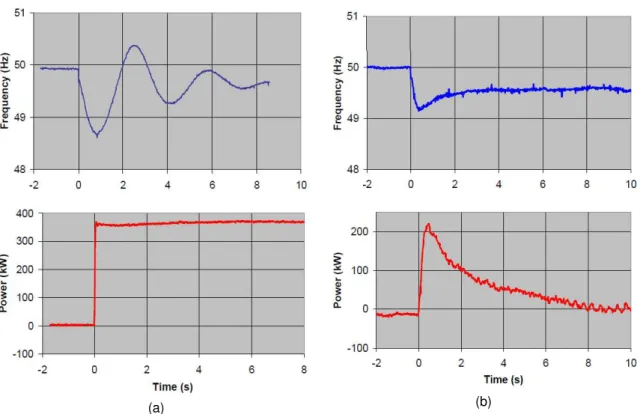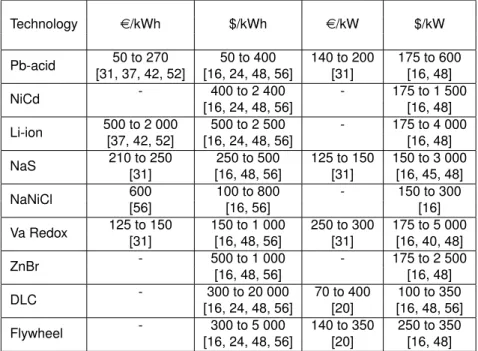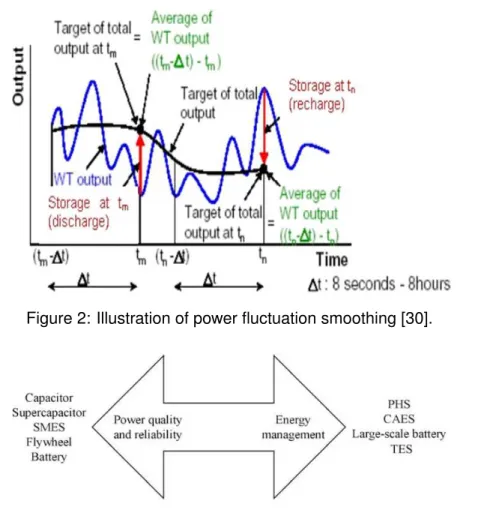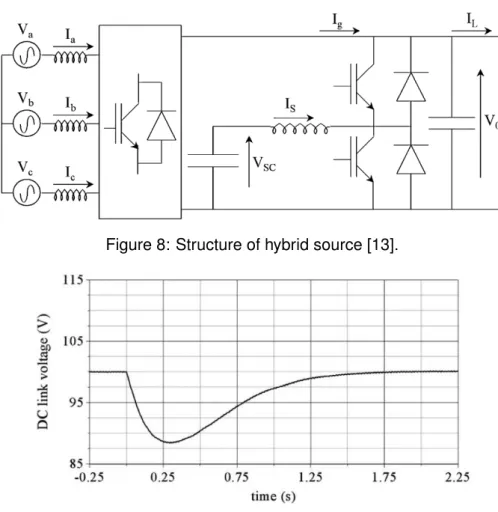However, in general, the requirements for energy storage systems suitable for the stabilization of mini-grids are similar to those suitable for the provision of ancillary services. Short-term power balancing (or bridging), related to mini-grid regulation, where the energy storage system absorbs or supplies energy to maintain a balance between immediate energy production and energy consumption in the mini-grid.
![Figure 1: Measured and modelled PV system output on a day with frequent passing clouds [56].](https://thumb-eu.123doks.com/thumbv2/1bibliocom/464907.70292/13.892.193.699.128.474/figure-measured-modelled-pv-output-frequent-passing-clouds.webp)
Energy and power density
Ideally, energy storage for mini-grid stabilization should have these characteristics: high power density, high efficiency, discharge duration at rated power (or higher if possible) for at least two minutes, high reliability, very fast response time, flexible ramp-up rate, and minimal efficiency change with discharge rate .
Efficiency
Discharge duration
Lifetime discharge
Reliability
Response Time
Ramp Rate
Charge Rate
Energy retention or “self discharge” time
Emergency Power
In terms of function, energy storage technologies can be divided into those primarily intended for high power with relatively small energy content, making them suitable for power quality and spinning reserve applications; and those designed for energy management (see section 3). This simple classification hides the wide range of technical parameters of energy storage devices. Electrical energy storage: i) Electrostatic energy storage (capacitors and supercapacitors); (ii) Magnetic/current energy storage (SMES).
Mechanical energy storage: i) Kinetic energy storage (flywheel); (ii) Potential energy storage (PHS and CAES). Chemical energy storage: Electrochemical energy storage (conventional batteries such as lead-acid, lithium-ion and flow-cell batteries such as zinc bromine and vanadium redox). Within the scope of this report, only available storage technologies for systems up to 100 kW are detailed.
Therefore, there are some storage technologies that are not described in this report because they are not available for small PV hybrid systems or are not suitable for this purpose due to their response time.
Nickel-cadmium batteries
Lead-acid (Pb-acid) batteries are one of the oldest and most developed battery technologies. Lead-acid batteries are commonly used in hybrid PV mini-grids for both stabilization and energy management applications. Although the technology is often used for energy management applications in PV systems, it has limitations due to its short life cycle (500 to 2,000 cycles) and low energy density (30 Wh/kg to 50 Wh/kg) due to its inherent high density of energy. pipe.
Lead-acid batteries also have an adequate operating range at ambient temperature for PV hybrid mini-grids, but performance degrades at temperatures below 0 °C and self-discharge accelerates at temperatures above 40 °C [16]. The main disadvantage of NiCd batteries is the relatively high price (around $1000/kWh) due to the expensive manufacturing process. NiMH batteries are also used in electric vehicles, which in this particular case need thermal management.
In stationary applications, NiMH batteries are currently not competitive with industrial NiCd batteries or with lead-acid batteries [29].
Lithium-ion batteries
Cadmium is a toxic heavy metal and therefore causes problems related to the disposal of NiCd batteries. NiCd batteries also suffer from "memory effect", where the batteries will only take full charge after a series of full discharges. Portable NiMH batteries were introduced in the 1990s for the rapidly growing mobile phone and laptop markets.
Portable NiMH batteries have similar characteristics and cell design to portable NiCd batteries, but the specific energy is about 50% higher [ 24 , 29 ]. However, NiMH technology generally has poorer power performance, higher self-discharge, greater sensitivity to overcharging and higher cost than NiCd technology. The figure 4 shows that the capacity remains almost constant for high charge or discharge current (here equal to 2 C).
To maintain stability and service life, the lithium-ion battery must be controlled with a monitoring unit.
Sodium sulphur batteries
In particular, to avoid overcharging and overdischarging, a voltage balance circuit is often installed to monitor the voltage of each individual cell and prevent voltage deviations between cells [22]. The main drawback is that a heat source is required that uses the stored energy of the battery itself, partially reducing the performance of the battery, since the NaS battery must operate at a high temperature as mentioned above. For everyday use, battery temperature can be maintained almost by its heat of reaction with suitably sized insulation.
These batteries are suitable for daily cycle applications, but are not suitable for long life and standby time UPS applications. However, the minimum module size is 50 kW, and it is currently not possible to use only one isolated module due to its thermal needs. Nevertheless, since the response time is on the order of milliseconds and NaS batteries meet the requirements for mini-grid stabilization, this technology could be very interesting for mini-grids if future research results in systems tailored to the needs of PV mini-grids. 44, 47].
As a practical example of this mini-grid stabilization technology, Figure 6 shows that the critical load voltage is well regulated thanks to the response of the NaS battery [45].
Sodium-nickel-chloride batteries
It is a high temperature system (approximately 300◦C) that uses nickel chloride as a positive electrode and can operate in a wide temperature range (-40◦C to +70◦C) without cooling. Compared to NaS batteries, NaNiCl batteries can withstand limited overcharge and discharge and have potentially better safety properties and a high cell voltage (2.58 V). The disadvantages regarding NaS batteries are their low energy density (about 120 Wh/kg) and power density (about 50 W/kg), although the former still represents a significant improvement over Pb-acid battery technology.
These batteries have been successfully implemented in several models of electric vehicles and represent interesting opportunities for use in the vehicle fleet. The NaNiCl battery is mostly an "energy" battery and therefore suitable mainly for battery electric vehicles; its specific power is quite modest for hybrid applications [38]. Currently, research is developing a high-performance version of the ZEBRA battery for hybrid electric vehicles, a high-energy version for renewable energy storage, and a load-balancing battery for industrial applications [16].
Redox-flow batteries: Va and ZnBr batteries
Vanadium redox-flow batteries
Among redox flow technologies, the vanadium redox flow battery (Va redox) is a particularly interesting variant, because vanadium can exist in four different valence levels, as a result of which vanadium can be used in both electrodes. The suitability of this technology for grid stabilization is demonstrated in the state of Utah (USA) where a 250 kW, eight-hour discharge vanadium redox battery system was installed to stabilize a long rural distribution line that was experiencing voltage stability problems due to load growth [15] .
Zinc-bromine (ZnBr) redox-flow batteries
Supercapacitors
Case Study
To illustrate the performance of DLCs in managing short-term electrical fluctuations, we consider the system studied by [13] (Figure 8), which consists of a controlled rectifier powered by a three-phase synchronous alternator and a DLC storage device connected to a DC link . through a current-reversible DC-DC converter. The generator is used as the main source of the system and the storage tank is used as transient power. The challenge was to regulate the DC link voltage and manage transient power demand, peak power and regenerative breaking by controlling both converters while respecting alternator and supercapacitor limitations.
The three-phase sinusoidal current system (Ia, Ib, Ic) is in phase with the three-phase sinusoidal voltage system (Va, Vb, Vc) in order to adjust the DC link voltage V0 to a reference level. VSC is the supercapacitor voltage. Figure 9 shows, for reference, the system voltage response to a load step when it is not supplied by supercapacitors. Load disturbances are created by generating square waves in the load current with an amplitude of 10 A.
Although the system used by [13] is not a hybrid PV system, these graphs show the ability of supercapacitors for voltage regulation.
![Figure 8: Structure of hybrid source [13].](https://thumb-eu.123doks.com/thumbv2/1bibliocom/464907.70292/31.892.197.699.137.341/figure-8-structure-of-hybrid-source-13.webp)
Flywheels
Case Study
The left column of the figure shows the measured system response (frequency and power), without the flywheel storage system, when a step load of 350 kW was placed on the system. The right column of the figure shows the system response (frequency and power) after installation of the flywheel energy storage. From Table 1, due to the energy efficiency, self-discharge values, energy density and life cycle, the technologies retained for the application of mini-grid stabilization are Li-ion, NaS, NaNiCl, Va redox, DLC and flywheel, while Pb-acid batteries remain an option due to their mature technology.
And from Table 3 it is noted that NiCd batteries have the problem of the toxicity of the cadmium. NiCd batteries have the serious problem of the environmental impact of cadmium in the production step and also for human health as it is identified as a carcinogenic substance [57]. Regarding environmental impacts for the four suitable technologies for mini-grid stabilization (Pb-acid, Li-ion, DLC and flywheel), Pb-acid batteries and flywheels therefore have the better environmental evaluation due to the recyclability of the former and because of neutrality for the latter.
However, to quantify this decrease, further research activities are required to quantify the environmental impacts of the processes involved.

Cost
For an energy storage application, a suitable metric can be e.g. be the price per kilowatt-hour of the energy delivered by the storage system during its lifetime. For those systems consisting of an energy storage device and a single power conversion system operating in both discharge and charge modes, the system capital cost is the sum of the component costs plus the balance of system costs. In Europe, within the framework of the implementation of the European Strategic Energy Technology Plan, energy storage has been identified as a critical technology for the transition to the operation of a more sustainable and low-carbon energy system.
These actions can be spread throughout the world to achieve the objectives of optimizing energy systems for all power spheres and taking into account the synergies achievable with energy storage. A comparison between different energy storage technologies is presented in terms of their suitability especially for the specific use of mini-grid stabilization. A review of short- and long-term response energy storage devices for power system applications.
Energy storage technologies for high penetration renewable energy networks and grid-connected PV systems.

![Figure 2: Illustration of power fluctuation smoothing [30].](https://thumb-eu.123doks.com/thumbv2/1bibliocom/464907.70292/18.892.232.664.132.419/figure-2-illustration-of-power-fluctuation-smoothing-30.webp)

![Figure 4: Energy capacity versus charging or discharging current for a Li-ion battery [22].](https://thumb-eu.123doks.com/thumbv2/1bibliocom/464907.70292/25.892.262.628.135.305/figure-energy-capacity-versus-charging-discharging-current-battery.webp)
![Figure 5: NaS battery [44]](https://thumb-eu.123doks.com/thumbv2/1bibliocom/464907.70292/26.892.229.669.132.517/figure-5-nas-battery-44.webp)
![Figure 6: Voltage regulation with NaS batteries [45].](https://thumb-eu.123doks.com/thumbv2/1bibliocom/464907.70292/27.892.260.633.130.533/figure-6-voltage-regulation-with-nas-batteries-45.webp)
![Figure 7: Schematic of flow battery [58]](https://thumb-eu.123doks.com/thumbv2/1bibliocom/464907.70292/28.892.192.700.131.422/figure-7-schematic-of-flow-battery-58.webp)

![Figure 11: Flywheel system [2]](https://thumb-eu.123doks.com/thumbv2/1bibliocom/464907.70292/32.892.268.627.461.726/figure-11-flywheel-system-2.webp)